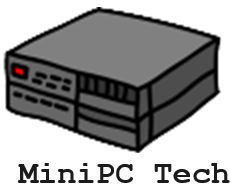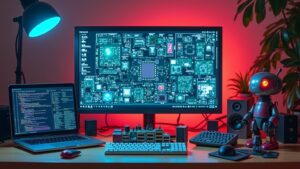How can Raspberry Pi Projects Boost Coding Skills?
Raspberry Pi projects boost coding skills in exciting ways. Start with networking projects like setting up a DHCP server to understand IP management. Try home automation tasks using GPIO pins to control devices, or program robots for real-world applications. You can also explore media center creations that enhance your software skills and game development for creative expression. Projects like weather stations not only teach coding but also data visualization. Each endeavor reinforces programming concepts and problem-solving skills. Stick around and discover even more inspiring projects that can elevate your coding journey!
Key Takeaways
- Programming sensors for motion detection and environmental monitoring enhances coding skills through practical application and problem-solving experiences.
- Projects like the SunFounder PiCar-X kit teach Python programming and sensor integration for real-world robotics applications.
- Developing a weather station using various sensors enhances coding skills while providing valuable data visualization and real-time insights.
- Engaging in game development with Pygame or Godot fosters creativity and flexibility in coding through the creation of interactive experiences.
- Building a media server with Kodi or a retro game console with RetroPie allows for hands-on coding practice and system management skills.
Networking and Server Management
Exploring networking and server management with Raspberry Pi can greatly enhance your coding skills while giving you hands-on experience with real-world applications.
By setting up a DHCP server, you can learn about IP address assignment and the intricacies of network management. This project requires configuring your Raspberry Pi OS and the DNSMasq package, allowing you to understand static IPs and DHCP ranges. Additionally, proper installation and configuration of network tools is critical for the success of your networking projects.
Network monitoring is another invaluable skill. Using NagiosPi, you can track system statuses and receive alerts on failures, which is essential for maintaining multiple servers. Additionally, as a network monitoring tool, Raspberry Pi can provide historical data tracking that aids in troubleshooting network issues.
Creating a Broadband Speed or Outage Monitor helps you grasp how to maintain network stability and optimizes your server’s performance.
If you’re inclined toward server management, consider establishing a NAS file server or print server. These projects not only teach you about secure file sharing and network printing but also provide insight into server optimization techniques.
Each project builds your coding proficiency and understanding of networking fundamentals, making Raspberry Pi an excellent platform for innovative developers like you.
Immerse yourself and elevate your skills through practical, hands-on experience!
Home Automation and IoT
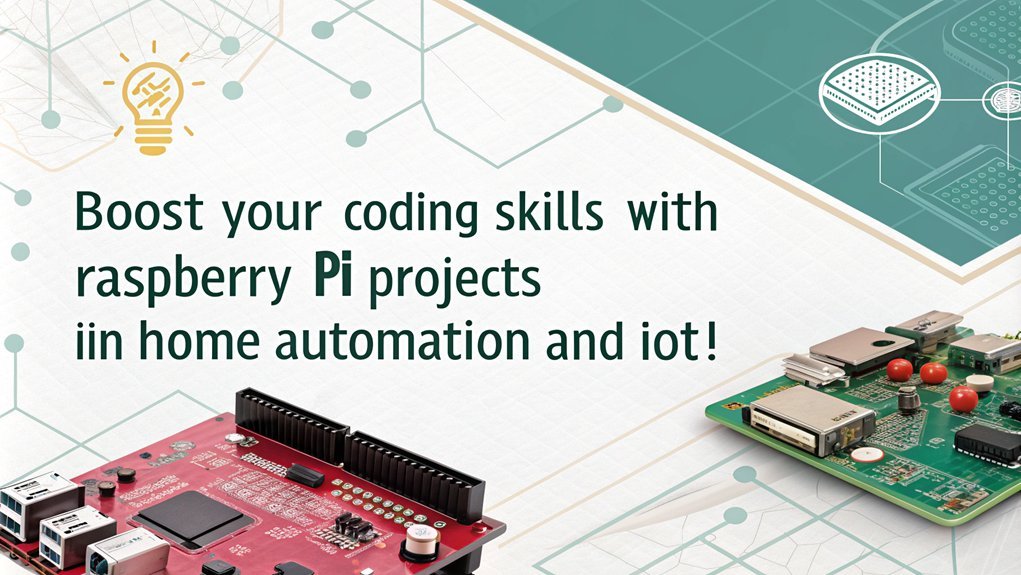
Home automation can transform your daily routine, making it more efficient and convenient. By automating appliances and integrating sensors, you can create a smart environment that responds to your needs. Plus, enhancing your network connectivity guarantees everything works seamlessly together, providing you with a truly connected home. Additionally, projects like Raspberry Pi Cat Feeder can further enhance your automation efforts by enabling features like automated pet feeding. The greater device connectivity provided by Raspberry Pi’s 40 GPIO pins allows for more complex and interactive home automation setups.
Automating Appliances Efficiently
With the rise of smart technology, automating your appliances efficiently can transform your living space into a connected haven. Using a Raspberry Pi, you can take control of your home by implementing appliance scheduling and energy monitoring, all from the palm of your hand.
Start by connecting lighting systems through a Relay Module, allowing you to manage your lights via a portable switch panel, tablet, or smartphone. Additionally, existing software like Homegenie and OpenRemote can serve as references to enhance your automation projects.
You can also automate thermostats to maintain your ideal temperature by configuring JSON settings in home automation software. Imagine adjusting your thermostat or locking your doors remotely—it’s all possible when you centralize your smart devices with the Raspberry Pi. This versatile platform opens up endless opportunities for integrating various IoT devices, making your home smarter.
Integrate with platforms like Homegenie or OpenRemote for seamless operation and explore the possibilities of voice control through digital assistants.
Sensor Integration Techniques
Integration of sensors opens up a world of possibilities for enhancing your home automation and IoT projects. By leveraging GPIO integration, you can easily connect sensors directly to the Raspberry Pi’s GPIO pins. Using libraries like RPi.GPIO, you can read data from digital and basic analog sensors with ADC applications, such as a temperature sensor on an analog pin.
For more complex setups, consider I2C communication or SPI interfaces. I2C allows short-distance communication with multiple devices, while SPI offers higher data transfer rates for longer distances. Both methods enable you to connect sophisticated sensors like the BME280 for temperature, humidity, and pressure readings. GPIO pins can also be used to directly control actuators, enhancing the interactivity of your projects. Additionally, the versatility of the Raspberry Pi’s applications means that you can experiment with various sensor types for different functionalities.
If you’re looking for simplicity, one-wire sensors like the DS18B20 are ideal. They require only one GPIO pin, making them easy to set up for basic temperature monitoring.
For projects demanding precise data, utilize ADCs like the MCP3008 to convert analog signals into digital data, enhancing sensor calibration and quality.
Don’t forget about data logging and sensor fusion techniques to combine multiple sensor inputs, providing richer insights into your environments. With these integration techniques, you can elevate your projects to new heights.
Enhancing Network Connectivity
Enhancing network connectivity is essential for creating a seamless home automation and IoT experience. Start by setting up your Raspberry Pi with a suitable OS like Raspberry Pi OS. Connect it to power and peripherals, then utilize MQTT plugins to integrate custom devices. This allows remote access and control, ensuring your home automation system is both effective and secure. Additionally, ensure that your Raspberry Pi has WiFi and Bluetooth capabilities to support multiple network connections for a more robust system.
Next, focus on integrating various IoT devices, like smart light bulbs and thermostats, using a Relay Module. This not only boosts device compatibility but also simplifies your home automation tasks. You can even create a central hub to manage multiple devices efficiently. Home Assistant is a widely adopted software that can help streamline this process.
Automate everyday tasks, such as pet feeding or delivery of items around your house, using innovative projects like a DIY home assistant robot. Combine this with monitoring tools on your Raspberry Pi to track network performance metrics, ensuring you maintain strong network security.
Lastly, leverage open-source tools for managing your network-connected devices, enabling you to enhance automation while safeguarding your home. By integrating these technologies, you’re not just boosting your coding skills; you’re also transforming your living space into a smart, efficient environment.
Sensor and Robotics Projects
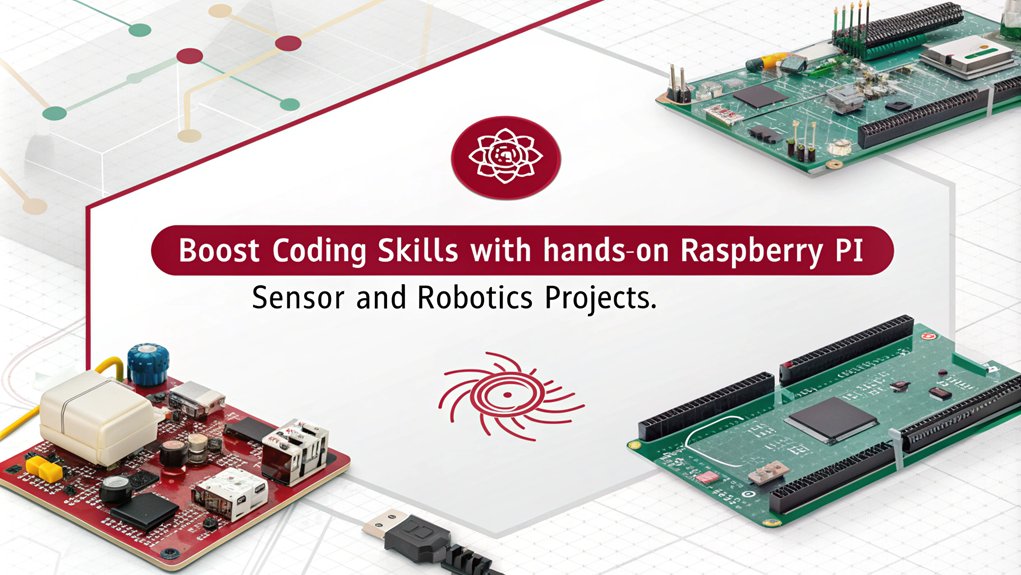
When you explore sensor and robotics projects, you’ll discover how practical applications can enhance your coding skills and understanding of technology. You can learn to program sensors for motion detection or environmental monitoring, and even control robots with Python. These hands-on experiences not only solidify your programming techniques but also open up a world of possibilities in automation and robotics. Additionally, utilizing variety of sensor kits tailored for educational use can provide a comprehensive learning experience. Engaging with Raspberry Pi robot kits allows you to develop problem-solving skills while creating innovative projects.
Practical Applications of Sensors
Many enthusiasts find that practical applications of sensors in Raspberry Pi projects open up exciting opportunities for learning and creativity.
By exploring sensor applications, you can immerse yourself in educational projects that not only enhance your coding skills but also introduce you to real-world problem-solving. For instance, you could create a weather station using temperature, humidity, and pressure sensors. This project allows you to gather and display data on a web interface, combining coding with data visualization. Additionally, leveraging a tiny, low-cost computer like the Raspberry Pi can make your projects more accessible and affordable. Incorporating infrared (IR) detectors in your motion sensor projects can further enhance their functionality and reliability.
Alternatively, integrating a motion sensor with a camera can lead to fascinating security applications, helping you understand how sensors interact in a system. Using kits like the CamJam EduKit 2 or resources from Pimoroni, you’ll find tutorials and Python code examples that make it easy to get started.
The Sense HAT emulator also lets you practice with environmental sensors in a simulated environment. Whether you’re measuring light with Adafruit’s sensors or developing an obstacle-avoiding robot with an ultrasonic module, your journey into sensor applications will be both educational and innovative.
Each project you undertake will sharpen your coding skills while igniting your creativity.
Robotics Programming Techniques
In the domain of robotics, mastering programming techniques is essential for bringing your projects to life. With Raspberry Pi, you can engage in various robotics projects that enhance your coding skills while exploring innovative concepts in robotics control and machine learning.
Take the SunFounder PiCar-X, for instance. This robot kit not only familiarizes you with Python programming but also integrates various sensors like cameras and ultrasonic modules. You’ll learn to control motors and detect obstacles, making it an excellent project for practical experience. Additionally, you can control a robot using an Android device, adding another layer to your programming skills. Furthermore, these projects often support various programming languages, allowing you to explore different coding paradigms.
Similarly, the Obstacle-Avoiding Robot reinforces your skills in Python and electronics, guiding you through object detection using IR sensors.
For more advanced applications, consider the Person Detection Security Robot, which leverages machine learning to recognize individuals and send alerts. This project will deepen your understanding of image processing with OpenCV and expand your programming capabilities.
Media and Entertainment

Whether you’re a movie buff, a music lover, or just looking to enhance your home entertainment setup, Raspberry Pi offers versatile projects that can elevate your media experience. You can transform your Pi into a powerful media center using Open Source Media Center (OSMC) or LibreELEC, both of which support seamless playback from local networks and the internet. If you’re aiming for 4K quality, the Raspberry Pi 4 is your go-to device.
Additionally, with a strong community support, you can find plenty of resources and troubleshooting help while setting up your media center. This innovation has contributed to the 40% of annual sales through commercial applications across various industries. Moreover, integrating a NAS can streamline access to your media libraries, enhancing your overall viewing experience.
For music streaming, the Pi Music Box project lets you access services like Spotify or set up internet radio using Volumio or Moode. You can control your music remotely via smartphone, making it easy to enjoy your favorite tunes.
If you’re dreaming of a home theater, build a 4K setup with Kodi and essential accessories like micro-HDMI cables and a reliable cooling solution, such as Pimoroni’s Fan SHIM. With these entertainment projects, you can access public domain films, stream live TV, and enjoy an extensive media experience that brings innovation right into your living room.
Weather and Environmental Monitoring

Harnessing the power of Raspberry Pi for weather and environmental monitoring can transform how you understand your surroundings. By utilizing various sensors, you can collect real-time data and make informed decisions. You’ll gain hands-on experience with sensor calibration and data visualization, enhancing your coding skills along the way. Additionally, you will need to set up a Raspberry Pi board to connect and operate the sensors effectively. The Pimoroni Enviro PHAT features a range of sensors including environmental sensors that can be utilized for comprehensive data collection.
Here’s a quick overview of some sensors you can integrate:
| Sensor Type | Functionality |
|---|---|
| DHT11 | Temperature and humidity readings |
| LDR | Light intensity measurements |
| Rain Sensor | Rainfall detection |
| BME280 | Temperature, pressure, humidity |
| MEMS I2S Mic | Noise level monitoring |
With these components, you can read and process data using protocols like I2C and single wire. Display this data locally on an LCD or send it to servers like ThingSpeak for remote analysis. You can even integrate your findings with platforms like Weather Underground for richer insights.
Software and Programming Techniques

Understanding your environment through weather monitoring is just the beginning of what you can achieve with Raspberry Pi. By diving into software and programming techniques, you can elevate your projects.
Start with Python, which is preinstalled on Raspbian, making it accessible for quick development. Utilize Python libraries like Rpi.GPIO for sensor projects or Twython for creating Twitter bots, enhancing your coding repertoire.
As you build, don’t overlook the importance of debugging techniques. They’ll help you identify and fix issues quickly. Code optimization and algorithm design are essential skills that improve the performance of your applications.
Implement software testing to guarantee your code runs smoothly and meets your project requirements. Version control is vital for managing changes in your codebase, especially in collaborative environments.
Customize your IDE, like using the Mu editor, to streamline your coding experience. Finally, project organization will keep your work structured, making it easier to track progress and collaborate.
With these skills, you’re not just coding—you’re innovating. Embrace the challenges and possibilities that Raspberry Pi offers, and watch your coding skills flourish.
Game Development With Raspberry Pi
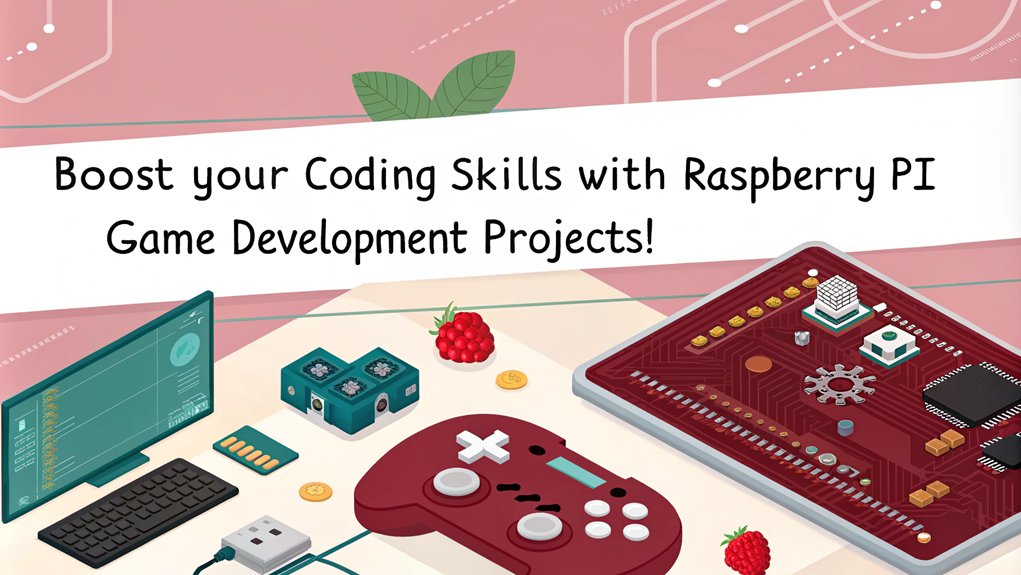
Creating games with Raspberry Pi opens up a world of fun and creativity, allowing you to bring your ideas to life while honing your programming skills. With a variety of tools and engines at your disposal, you can plunge into game development easily. Here are some exciting options to reflect on:
- Pygame tutorials for flexible game creation using Python.
- Scratch games that introduce beginners to interactive programming.
- Godot projects for those ready to explore 2D and 3D game development.
- Pico8 creations for simplified game design in a retro aesthetic.
Whether you’re building 2D games with the Solarus engine or venturing into more complex Unity development, Raspberry Pi offers endless possibilities.
You can also use Adventure Game Studio for narrative-driven projects or leverage Minecraft tutorials available on the Raspberry Pi website.
Don’t forget to check out community resources like the RetroPie forums and The MagPi Magazine for invaluable insights.
The combination of creativity and technical skill makes game development with Raspberry Pi a rewarding experience, helping you become a more proficient coder while having a blast!
Creative Projects for Beginners

Exploring creative projects with Raspberry Pi can ignite your imagination while building valuable coding skills.
For beginners diving into creative coding, consider starting with a media server using Kodi. It’s a fantastic way to learn about streaming technologies while customizing your entertainment options.
If music is your passion, try creating a button-controlled music box that plays various sounds when buttons are pressed. It’s simple yet engaging, making it perfect for novice coders.
Another exciting project is building an internet radio that streams your favorite online stations, combining both coding and music enjoyment.
If you’re feeling nostalgic, turn your Raspberry Pi into a retro game console with RetroPie. This beginner project not only teaches you about emulation but also gives you the chance to relive classic games.
For a touch of automation, why not build a weather station using sensors? You’ll gather real-time data while honing your programming skills.
Each of these projects provides a hands-on experience, allowing you to explore and innovate. Embrace these beginner projects, and watch your coding skills flourish!
Frequently Asked Questions
Which Programming Languages Are Best for Raspberry Pi Projects?
For Raspberry Pi projects, consider Python for machine learning and GPIO control, Scratch for engaging programming, C++ for performance-critical applications, and JavaScript for web programming or IoT integration. Each language offers unique advantages for innovation.
How Do I Choose the Right Raspberry Pi Model for My Project?
Choosing the right Raspberry Pi model depends on your project requirements. For high-performance tasks, opt for the Raspberry Pi 4 Model B; for simpler projects, the Raspberry Pi Zero W is more budget-friendly and efficient.
What Are Common Troubleshooting Tips for Raspberry Pi Projects?
When troubleshooting Raspberry Pi projects, check for error messages, apply debugging techniques, and address hardware issues. Regular software updates enhance performance, ensuring everything runs smoothly and efficiently for your innovative projects.
Can I Use Raspberry Pi for Commercial Projects or Applications?
When diving into commercial projects, consider licensing, hardware limitations, and market applications. A thorough cost evaluation guarantees your innovation thrives, turning Raspberry Pi into a powerful tool for transformative solutions across industries.
How Do I Optimize Performance for Raspberry Pi Projects?
To optimize performance for your Raspberry Pi projects, focus on performance tuning and resource management. Install a lightweight OS, remove unnecessary software, overclock the CPU, enable GPU acceleration, and upgrade hardware for enhanced efficiency.
Where do you go from Here to Boost Your Coding Skills with a Raspberry Pi?
In the world of Raspberry Pi projects, each project is like a stepping stone across a stream, guiding you toward greater coding skills. Whether you’re setting up a server or automating your home, each challenge sharpens your abilities and fuels your creativity. So, grab your Raspberry Pi and immerse yourself! Embrace the journey, and you’ll not only enhance your coding skills but also access a universe of possibilities that await just beyond the horizon.

I am a retired software engineer with experience in a multitude of areas including managing AWS and VMWare development environments. I bought a relative a mini-PC a year ago and have become passionate about the technology and its potential to change how we deploy software.
